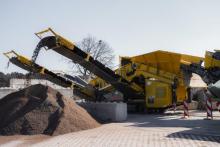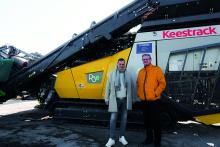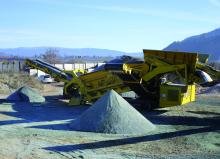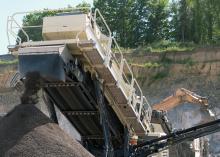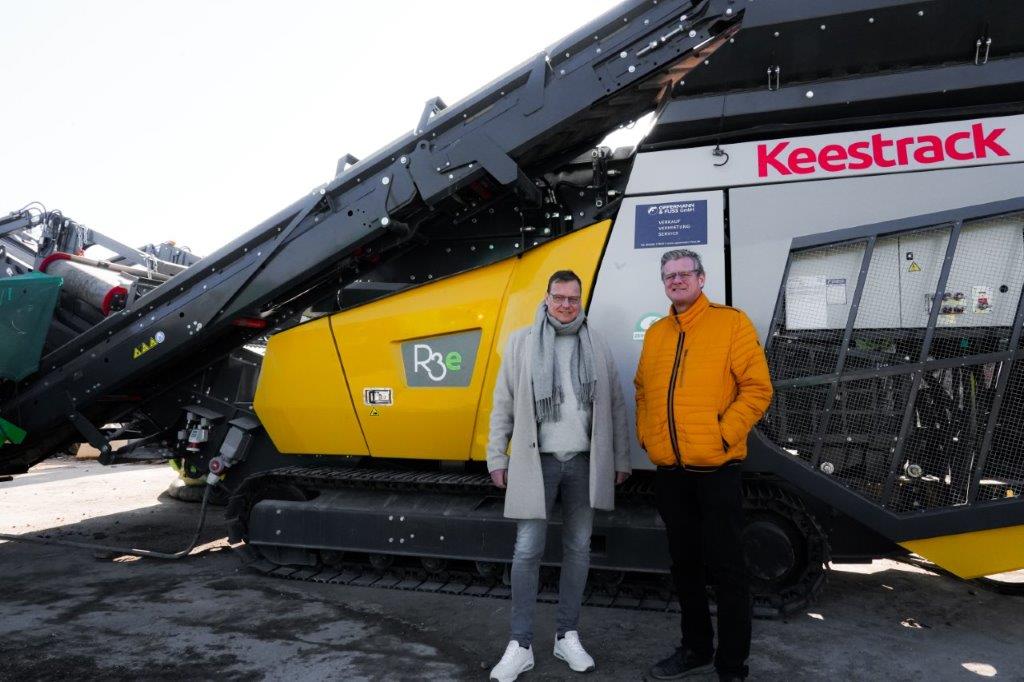
The primary raw materials for the load-bearing and non-load-bearing interior wall elements consist of material that was 100% recycled.
Büscher has completely replaced sand and gravel with mixed construction and demolition waste to produce load-bearing and non-load-bearing precast concrete elements for interior walls.
The German Federal Association for Building Materials has given its approval for crushed sand similar to type 3 to be used in Büscher's prefab load-bearing and non-load-bearing interior wall elements in exposure classes XC1 and X0 (dry).
The Büscher site is equipped with solar panels delivering up to 323 kW/h of renewable electricity that is used to power the concrete factory. The panels also provided power for the Keestrack R3e ZERO impact crusher and the K4e ZERO screen used in building the new house. Both machines are fully electric, powered by renewable energy and do not have a combustion engine onboard.
As the electric motors drive most of the mobile crushing and screening equipment and power some necessary hydraulics systems both Keestrack machines run with zero CO2 emissions.
When plugged in to the grid, like at the Büscher recycling site which uses renewable energy from photovoltaic solar panels, the R3 and K4 produce at zero carbon emission. The energy cost will be approximately 152kWh, and operational and maintenance cost will decrease drastically as there is no engine on board to maintain.
The R3 impact crusher has won several European design prizes, including the Red Dot award. The compact and easy to transport impact crusher is available in: diesel/hydraulic drive, electric plug-in drive (with onboard backup diesel gen-set) and ZERO drive: full electric plug-in without gen-set backup, has a capacity up to 250t/h.
The Büscher company chose the ZERO versions to minimise the environmental impact as it runs at zero carbon footprint, powered by its own solar energy.
The R3e ZERO is equipped with a vibrating feeder with a pre-screen of 1.200mm x 920mm to optimize crushing results and to minimise wear, an inlet opening of 770mm x 960mm (HxW) and a rotor diameter of 1.100mm and a rotor width of 920mm. The crusher equipped in closed circuit with recirculation conveyor and a precession screen of 3.100mm x 1.400mm produces a defined aggregate product size. The installed wind sifter eliminates contaminations of plastics, wood or paper and the overband magnet separates the metals. The R3e ZERO weighs 32t, and its plug-out of 125A, powers the connected K4e ZERO of 28t.
The K4e ZERO, has a high productivity with a capacity up to 350t/h. The double deck screen box of 4.200mm x 1.500mm, standard heavy duty plate apron feeder and hydraulic adjustable screen angle gives it very good screening capabilities. The numerous available options and screen decks make the K4 suitable for each job. At the recycling site of Büscher they choose to have the fine and middle fraction conveyor at the same side of the screen to improve the accessibility for the wheel loader.
Both Keestrack machines at Büscher are equipped with remote controls to operate the crusher and screen from the excavator. They both have an integrated water spray system which can be used in case the production is too dusty. Also both are equipped with a Keestrack-er UMTS system. This telematics software system provides real-time data and analytics. The system enables you to check the location of the machines and if they are working correctly. All aspects of a machine can be checked and if necessary, remote updates to the software can be made. It is possible to run diagnostic tests for all components including the feeder, screen, crusher and conveyors. The Keestrack-er also functions well for maintenance planning by Oppermann & Fuss, helping to keep machines in optimum shape.
“By now all scientific research has been done and it shows exactly what is possible with the 100% recycled prefab concrete and concrete elements. The new material functions perfect and the recipe has changed at Büscher,” says Hans-Jürgen Büscher, who operates the company with his brother Wolfgang.
The firm says the main advantage of its certified production process is the low use of resources. Construction waste that is locally available in large quantities and thus reduces CO2 emissions during transport is processed into a sustainable and climate-neutral product.
Büscher managing director Thomas Overbeeke comments: "We want to make our process known nationwide and would be happy if other concrete plants, recycling companies and other interested parties on the subject of sustainable building with secondary building materials contact us. The construction industry is facing a comprehensive transformation. New approaches are necessary so that the building materials used do not end up as waste - we can and are allowed to do this with the Büscher wall."
Oppermann & Fuss, the Keestrack dealer in Germany, advised Büscher which ZERO equipment was the best fit for its applications and capacity.

